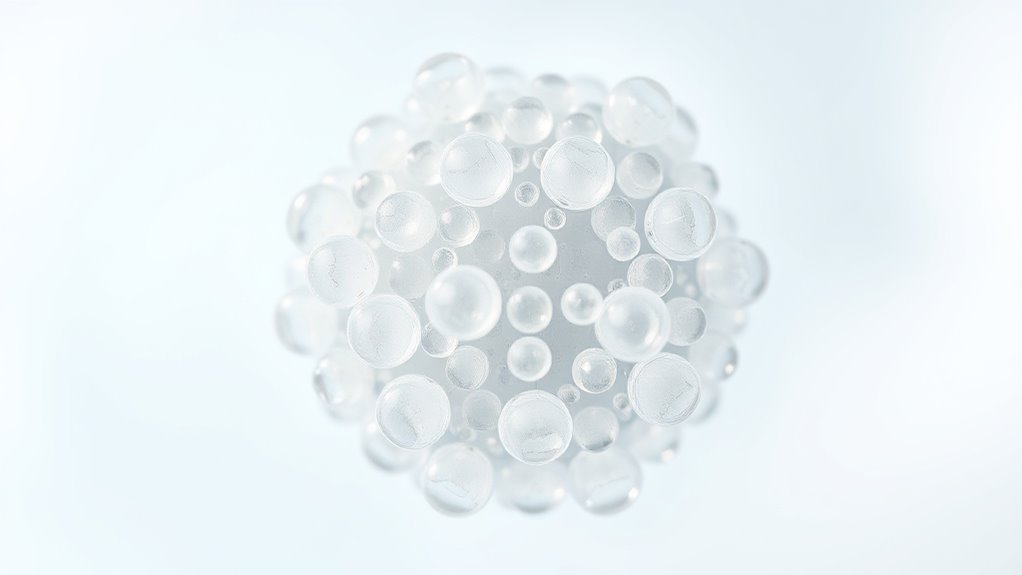Exosomes in dermatology show great potential to boost skin regeneration by delivering beneficial molecules that stimulate collagen production, improve elasticity, and speed up wound healing. They offer a cell-free alternative to traditional treatments, reducing risks like immune reactions or tumor formation. However, safety concerns remain, including possible unwanted cell growth and variability in exosome quality. To understand how this innovative therapy balances promise with precautions, keep exploring further.
Key Takeaways
- Exosomes can promote skin regeneration by stimulating collagen production and enhancing wound healing in dermatological treatments.
- They offer a cell-free approach, reducing immune rejection and tumor risk compared to traditional cell therapies.
- Safety concerns include potential unwanted cell proliferation and immune reactions due to complex exosome content.
- Variability in exosome isolation and standardization poses challenges for consistent and safe clinical application.
- Rigorous testing and regulation are essential to balance therapeutic benefits with safety in using exosomes in dermatology.

Exosomes, tiny extracellular vesicles released by cells, are increasingly recognized for their potential in dermatology. These nanometer-sized particles carry proteins, lipids, and nucleic acids that facilitate intercellular communication, making them promising tools for promoting skin health. Researchers are exploring how exosomes can be harnessed to enhance cell therapy and skin regeneration, offering new hope for treating various skin conditions. Unlike traditional treatments, exosome-based therapies target specific cellular pathways, potentially leading to more effective and natural skin repair processes.
Exosomes are promising tools for skin repair and regeneration in dermatology.
In the domain of cell therapy, exosomes serve as mediators that deliver regenerative signals directly to skin cells. When applied to damaged skin, they can stimulate fibroblasts to produce collagen, elastin, and other essential extracellular matrix components. This activity supports skin renewal, improves elasticity, and reduces fine lines and scars. Because exosomes are derived from stem cells or other therapeutic cells, they carry bioactive molecules that mimic the beneficial effects of cell therapy without the risks associated with transplanting live cells, such as immune rejection or tumor formation. Their stability and ability to cross biological barriers make them attractive candidates for minimally invasive skin treatments.
For skin regeneration, exosomes offer a cell-free approach that encourages healing and tissue remodeling. They can be sourced from various cell types, including mesenchymal stem cells, which are known for their regenerative properties. When introduced into the skin, exosomes promote angiogenesis, reduce inflammation, and accelerate wound healing. This multifaceted effect can be particularly beneficial for chronic wounds, burns, or skin aging. Because they carry targeted molecular cargo, exosomes can be customized to address specific skin issues, making personalized dermatological therapies more feasible. Furthermore, their ability to be stored and standardized enhances their practicality for clinical use.
However, despite these promising applications, safety concerns remain. The complexity of exosome content means that unintended effects, such as promoting unwanted cell proliferation or immune reactions, are possible. There’s also the challenge of ensuring consistent quality in exosome preparations, as variability can impact safety and efficacy. As research advances, rigorous testing and standardization are essential to mitigate these risks. While exosomes hold tremendous potential for revolutionizing skin regeneration and cell therapy strategies, their translation into routine clinical practice must be approached cautiously, balancing innovation with safety. Additionally, ongoing research into AI technologies could improve the analysis and customization of exosome therapies, further enhancing their safety and efficacy.
Frequently Asked Questions
How Do Exosomes Differ From Other Regenerative Therapies in Dermatology?
You’ll find exosomes differ from other regenerative therapies because they facilitate cellular communication through their bioactive cargo, like proteins and RNAs. Unlike stem cell treatments, exosomes deliver these molecules directly to target cells, promoting healing without the risks of cell rejection or tumor formation. This targeted approach enhances tissue regeneration efficiently, making exosomes a promising, safer alternative that harnesses natural biological processes for skin repair and renewal.
What Are the Long-Term Safety Implications of Using Exosome-Based Treatments?
Imagine the future of skincare—exosomes could hold the key. While their long-term safety still needs more study, you should be aware of potential immune reactions that might occur over time. Concerns about long-term efficacy also exist, as the durability of benefits may vary. Staying informed and consulting with dermatology professionals can help you weigh these risks, ensuring your treatment choices prioritize safety and lasting results.
Are There Specific Skin Conditions That Respond Better to Exosome Therapy?
You’ll find that exosome therapy works particularly well for targeted skin rejuvenation, helping improve skin texture and firmness. It also shows promise in acne scar treatment by promoting collagen production and healing. While results vary, these treatments often yield better outcomes for those with specific concerns like aging or scarring. To maximize benefits, consult your dermatologist to see if exosome therapy suits your skin condition.
How Is the Quality and Purity of Exosome Products Regulated?
Think of exosome products like fine wines; their quality depends on careful crafting. You should know that standardized manufacturing processes and rigorous regulatory oversight guarantee these products meet safety and purity standards. Regulatory agencies, like the FDA, set guidelines to maintain consistency, so you can trust that reputable providers follow strict protocols. This way, you’re assured of receiving high-quality, safe exosome therapies that deliver the best results for your skin.
Can Exosome Treatments Be Combined With Existing Dermatological Procedures?
Yes, you can combine exosome treatments with existing dermatological procedures through combination techniques and procedural integration. These approaches enhance outcomes by leveraging the regenerative properties of exosomes alongside treatments like microneedling, laser therapy, or chemical peels. Always consult with your dermatologist to guarantee proper coordination, as combining treatments requires careful planning to maximize safety and effectiveness while minimizing risks.
Conclusion
You now see how exosomes hold incredible promise for transforming dermatology, offering revolutionary treatments that could change skin healing forever. But beware—despite their potential, safety concerns loom like dark clouds on the horizon. As research advances, you’ll need to stay informed and cautious, because rushing into uncharted territory could lead to unforeseen consequences. Embrace the future wisely—exosomes could be the key to flawless skin, or a Pandora’s box if mishandled. The choice is yours.









